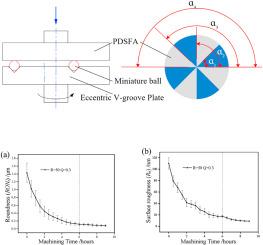用固定磨料的不连续扇形盘加工微型球的v型槽性能的影响
IF 3.7
2区 工程技术
Q2 ENGINEERING, MANUFACTURING
Precision Engineering-Journal of the International Societies for Precision Engineering and Nanotechnology
Pub Date : 2025-06-09
DOI:10.1016/j.precisioneng.2025.06.001
引用次数: 0
摘要
为了实现微型球的高效、高精度加工,本研究提出了一种采用固定磨料不连续扇区(PDSFA)的新型研磨方法。该方法通过改变不同板段之间的摩擦系数,促进了球表面形成均匀、全覆盖的研磨轨迹,提高了加工精度和效率。建立了偏心v型槽的运动学模型,分析了偏心v型槽的特性及其对加工轨迹分布的影响。仿真和实验结果表明,优化槽型偏心可以显著改善轨迹均匀性和覆盖范围。搭建实验平台,利用GGr15轴承钢微球对PDSFA方法进行性能评估。在最佳偏心度为0.3时,经过6 h的研磨,球的平均圆度(front)为0.118 μm,表面粗糙度(Ra)为17.5 nm。在随后的3小时抛光过程中,进一步将front减小到0.082 μm(±0.02 μm), Ra减小到9 nm(±0.8 nm),证明了该方法的有效性和精度。本文章由计算机程序翻译,如有差异,请以英文原文为准。

Effects of the V-groove property for machining miniature balls using a plate with discontinuous sectors of fixed abrasives
To achieve efficient, high-accuracy machining of miniature balls, this study proposes a novel lapping method using a plate with discontinuous sectors of fixed abrasives (PDSFA). By varying friction coefficients across different plate sectors, the method promotes the formation of uniform, full-coverage lapping trajectories on the ball surface, enhancing machining accuracy and efficiency. A kinematic model is developed to analyze the properties of the eccentric V-groove and its effect on the distribution of the machining trajectory. Simulation and experimental results confirm that optimizing groove eccentricity significantly improves trajectory uniformity and coverage. An experimental platform was constructed to evaluate the performance of the PDSFA approach using GGr15 bearing steel miniature balls. At an optimal groove eccentricity degree of 0.3, after 6 h of lapping, the balls achieved an average roundness (RONt) of 0.118 μm and surface roughness (Ra) of 17.5 nm. A subsequent 3-h polishing process further reduced RONt to 0.082 μm (±0.02 μm) and Ra to 9 nm (±0.8 nm), demonstrating the method's effectiveness and precision.
求助全文
通过发布文献求助,成功后即可免费获取论文全文。
去求助
来源期刊
CiteScore
7.40
自引率
5.60%
发文量
177
审稿时长
46 days
期刊介绍:
Precision Engineering - Journal of the International Societies for Precision Engineering and Nanotechnology is devoted to the multidisciplinary study and practice of high accuracy engineering, metrology, and manufacturing. The journal takes an integrated approach to all subjects related to research, design, manufacture, performance validation, and application of high precision machines, instruments, and components, including fundamental and applied research and development in manufacturing processes, fabrication technology, and advanced measurement science. The scope includes precision-engineered systems and supporting metrology over the full range of length scales, from atom-based nanotechnology and advanced lithographic technology to large-scale systems, including optical and radio telescopes and macrometrology.

 求助内容:
求助内容: 应助结果提醒方式:
应助结果提醒方式:


